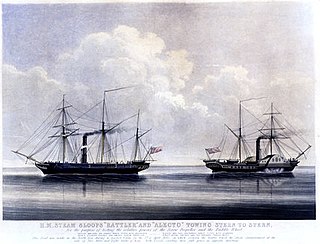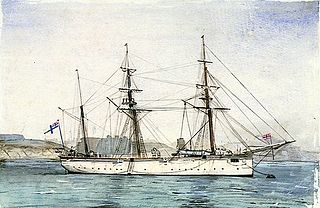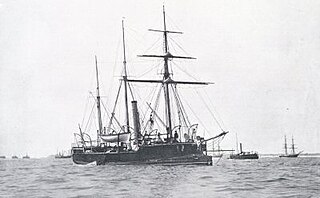
Steam frigates and the smaller steam corvettes, steam sloops, steam gunboats and steam schooners, were steam-powered warships that were not meant to stand in the line of battle. The first such ships were paddle steamers. Later on the invention of screw propulsion enabled construction of screw-powered versions of the traditional frigates, corvettes, sloops and gunboats.

The first HMS Shah was a nineteenth-century unarmoured iron hulled, wooden sheathed frigate of Britain's Royal Navy designed by Sir Edward Reed. She was originally to be named HMS Blonde but was renamed following the visit of the Shah of Persia in 1873.

HMS Research was a small ironclad warship, converted from a wooden-hulled sloop and intended as an experimental platform in which to try out new concepts in armament and in armour. She was launched in 1863, laid up in 1878 and sold for breaking in 1884, having displayed serious limitations as a warship.

HMS Penelope was a central-battery ironclad built for the Royal Navy in the late 1860s and was rated as an armoured corvette. She was designed for inshore work with a shallow draught, and this severely compromised her performance under sail. Completed in 1868, the ship spent the next year with the Channel Fleet before she was assigned to the First Reserve Squadron in 1869 and became the coast guard ship for Harwich until 1887. Penelope was mobilised as tensions with Russia rose during the Russo-Turkish War of 1877–78 and participated in the Bombardment of Alexandria during the Anglo-Egyptian War of 1882. The ship became a receiving ship in South Africa in 1888 and then a prison hulk in 1897. She was sold for scrap in 1912.

HMS Vixen was an armoured composite gunboat, the only ship of her class, and the third ship of the Royal Navy to bear the name. She was the first Royal Navy vessel to have twin propellers.

HMS Rattler was a 9-gun steam screw sloop of the Royal Navy, and one of the first British warships to be completed with screw propulsion. She was originally ordered as a paddle wheel 4-gun steam vessel from Sheerness Dockyard on 12 March 1841. She was reordered on 24 February 1842 as a propeller type 9-gun sloop from HM Royal Dockyard, Sheerness, as a new vessel. William Symonds had redesigned the ship as a screw propeller driven vessel.

HMS Marlborough was a first-rate three-decker 131-gun screw ship built for the Royal Navy in 1855. She was begun as a sailing ship of the line, but was completed to a modified design and converted to steam on the stocks, and launched as a wooden steam battleship.

HMS Malabar was a Euphrates-class troopship launched in 1866, and the fifth ship of the Royal Navy to employ the name. She was designed to carry troops between the United Kingdom and British India, and was employed in that role for most of her life. She became the base ship at the Royal Naval Dockyard, Bermuda in 1897. She was renamed Terror in 1901 and sold in 1918. Her name was later used as the stone frigate to which shore personnel in Bermuda were enrolled, and later for Her Majesty's Naval Base Bermuda, after the 1950s, when the dockyard was reduced to a base.

HMS Dryad was the name ship of the Dryad-class torpedo gunboats. She was launched at Chatham Dockyard on 22 November 1893, the first of the class to be completed. She served as a minesweeper during World War I and was broken up in 1920.

HMS Mariner was the name-ship of the Royal Navy Mariner-class composite screw gunvessel of 8 guns.

The Conqueror-class ships of the line were a class of two 101-gun first rate screw propelled ships designed by the Surveyor’s Department for the Royal Navy.

HMS Wasp was a Banterer-class composite screw gunboat of the Royal Navy, built in 1880 by Barrow Iron Shipbuilding and wrecked off Tory Island in 1884.

The Aetna-class ironclad floating batteries were built during the Crimean War for the attack of Russian coastal fortifications.

HMS Raven was a Banterer-class gunboat of the Royal Navy, built by Samuda Brothers of Poplar, London, and launched on 18 May 1882. She served on the Australia Station and was converted to a diving tender in 1904. After being lent as a training ship in 1913 she was sold for breaking in 1925.

HMS Waterwitch was one of only three armoured gunboats built for the Royal Navy. Uniquely, she was powered by Ruthven's "hydraulic propeller", making her the first ship to employ waterjets. She was launched in 1866 and conducted comparative trials with her two sister ships. She was not employed operationally and was sold in 1890.

The Medina-class gunboat was a class of 12 Royal Navy Rendel gunboats mounting three 6.3-inch guns, built between 1876 and 1877. Flat-iron gunboats were normally built without masts or rigging, but the Medinas carried a full barquentine rig. Their robust iron hulls meant that they lingered on as diving tenders, barges and lighters, with five of them working into the 1920s. The hull of Medway lies in shallow water in Bermuda and is visible on satellite imagery.

The Banterer-class gunboat was a class of eleven gunboats mounting two 6-inch and two 4-inch guns, built for the Royal Navy between 1880 and 1892.

The Albacore-class gunboat, also known as "Crimean gunboat", was a class of 98 gunboats built for the Royal Navy in 1855 and 1856 for use in the 1853-1856 Crimean War. The design of the class, by W. H. Walker, was approved on 18 April 1855. The first vessels were ordered the same day, and 48 were on order by July; a second batch, which included Surly, were ordered in early October.
HMS Horatio was a Royal Navy 38-gun fifth-rate Lively-class frigate, built out of fir timbers at the yard of George Parsons in Bursledon.


















